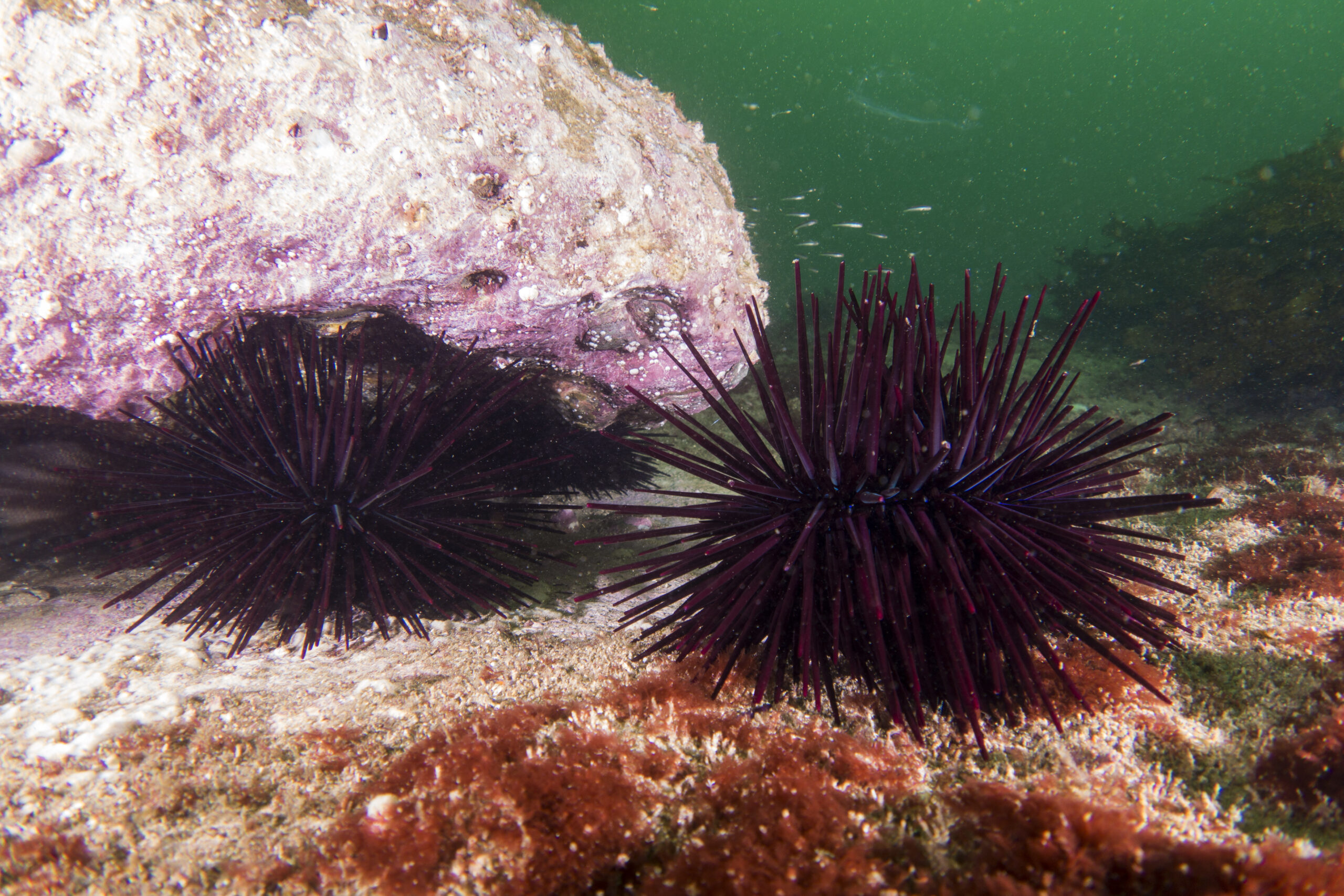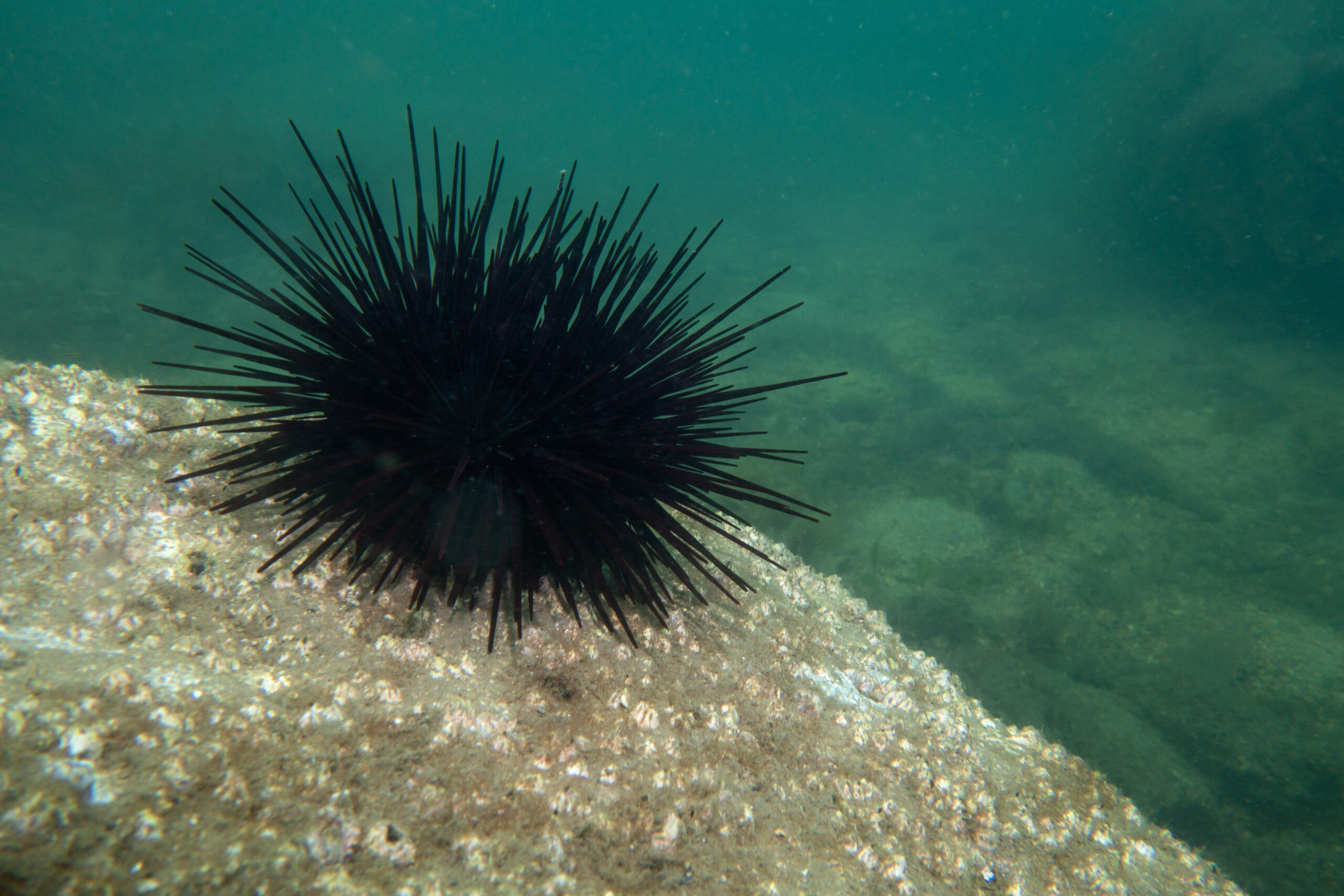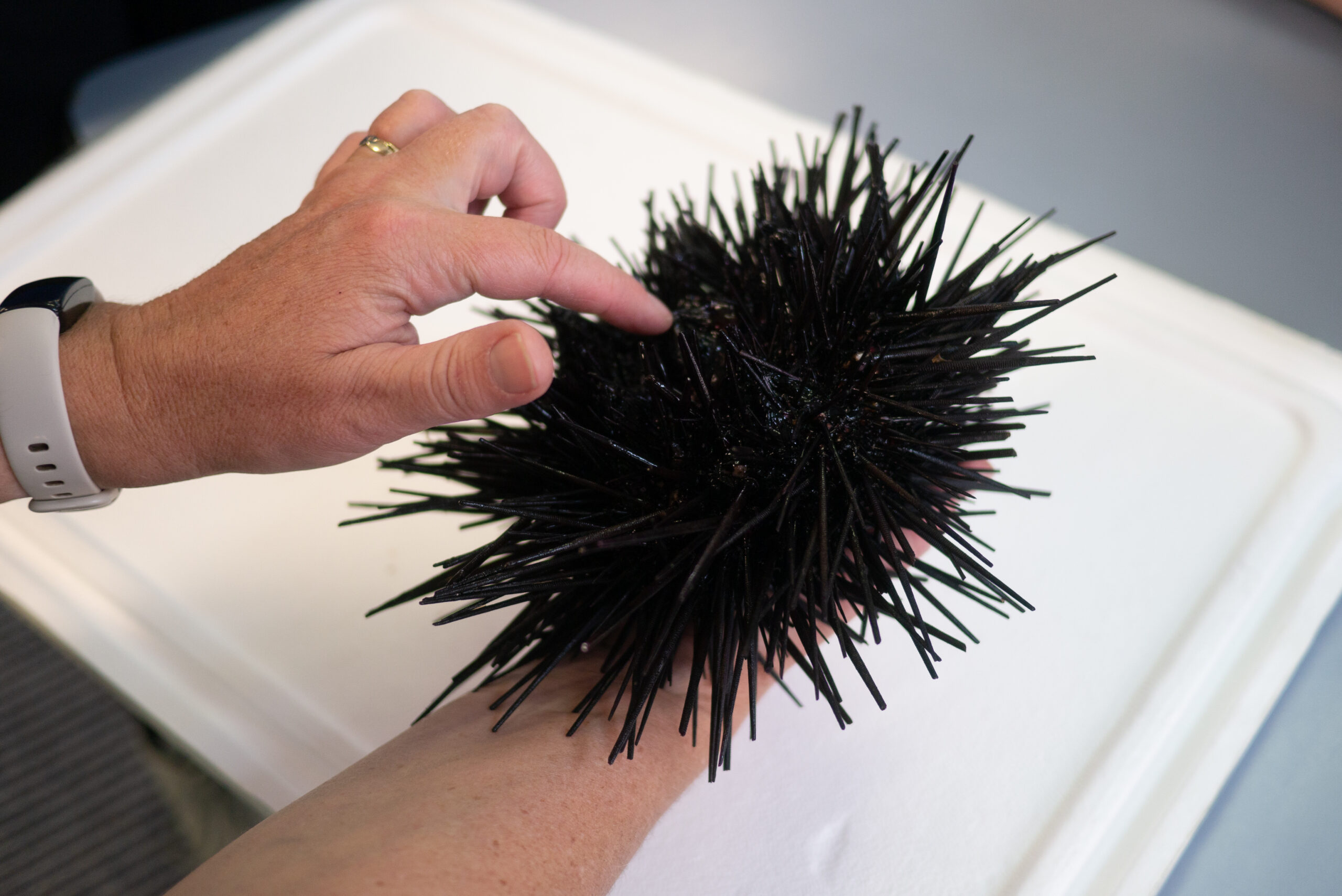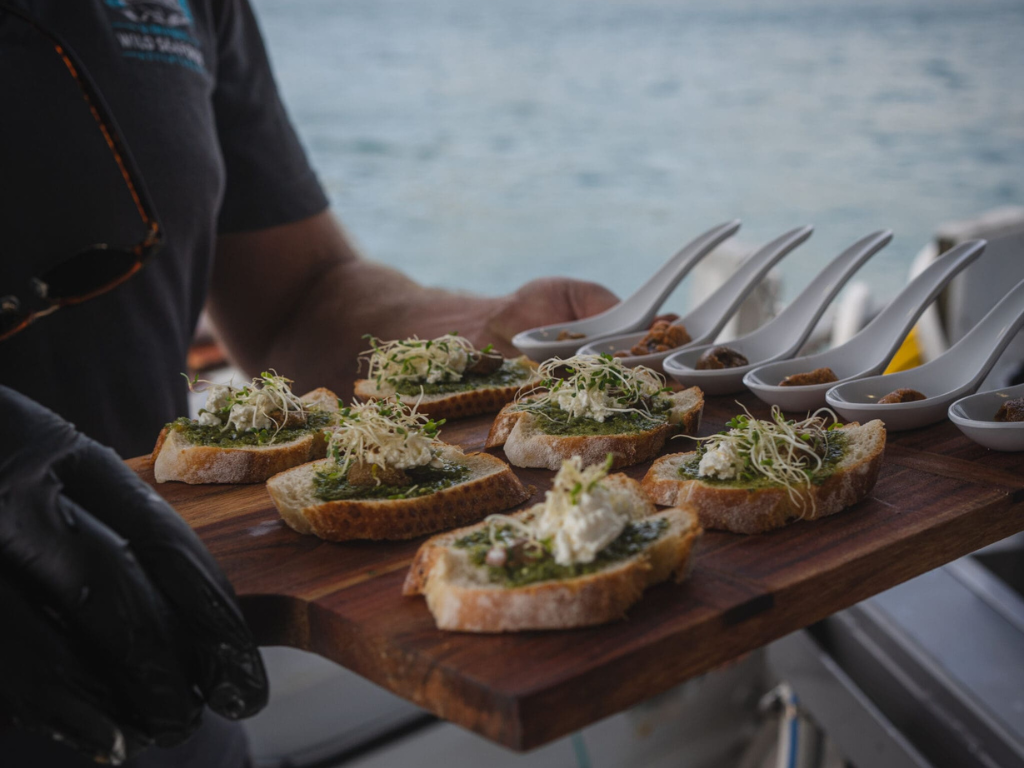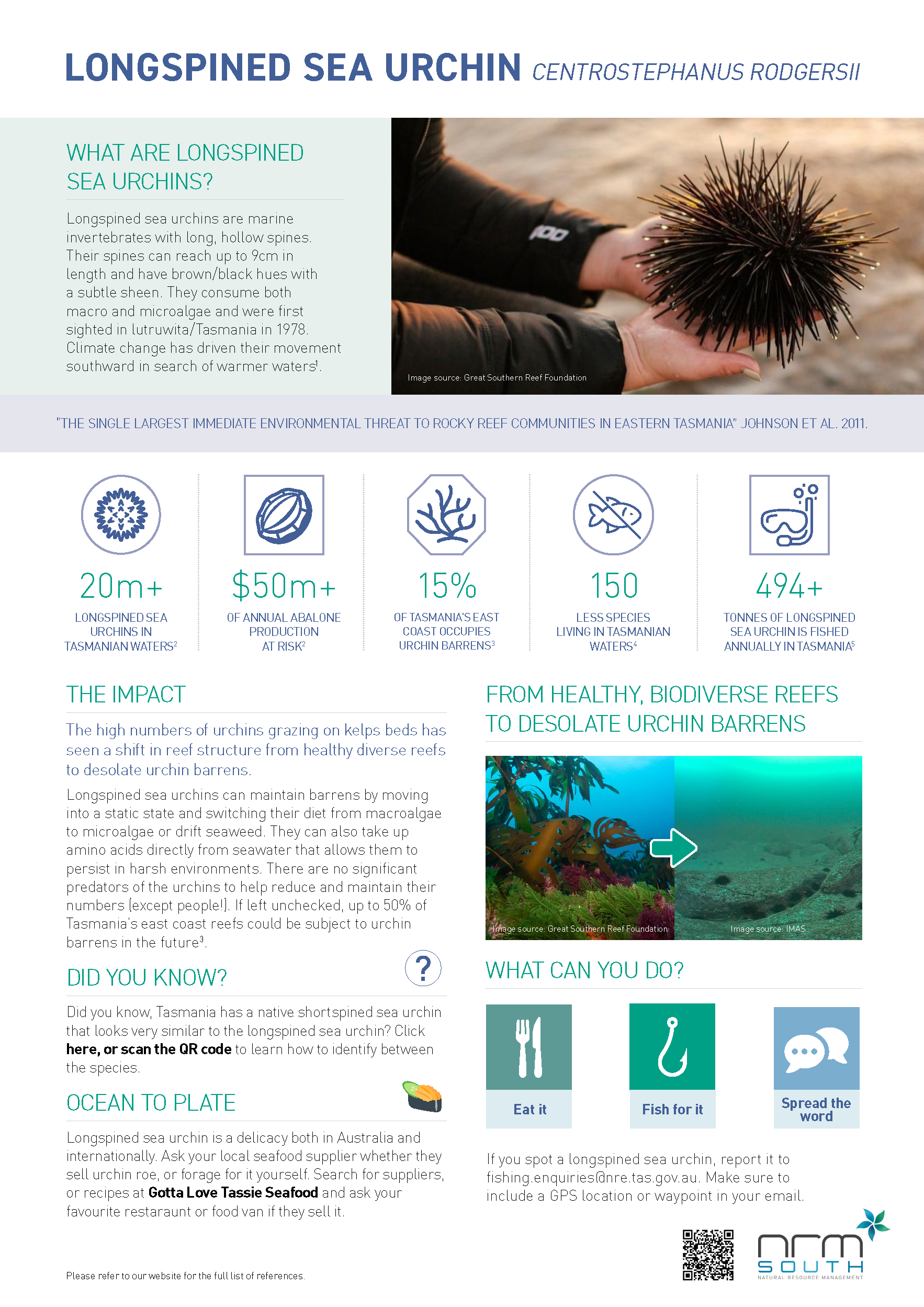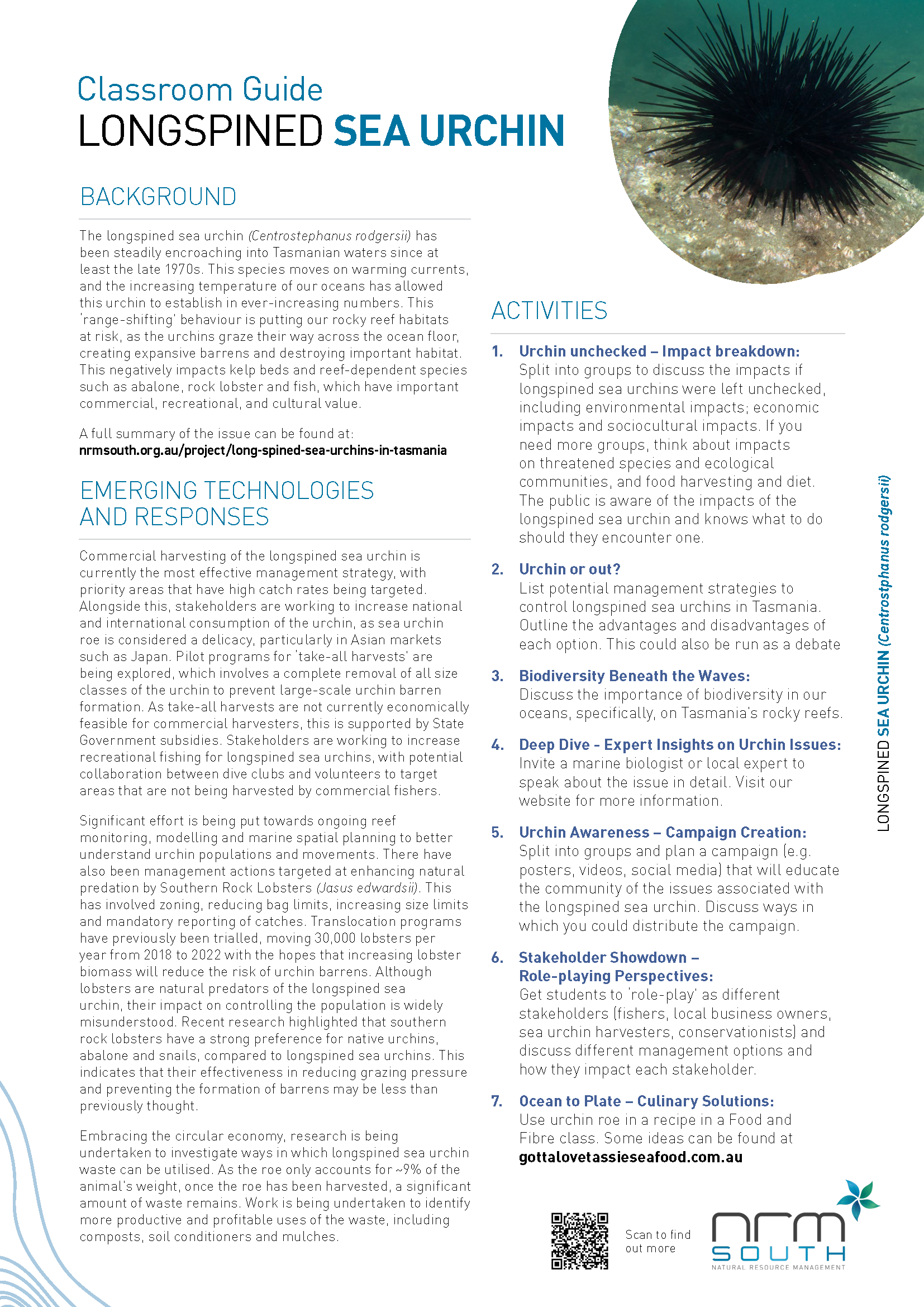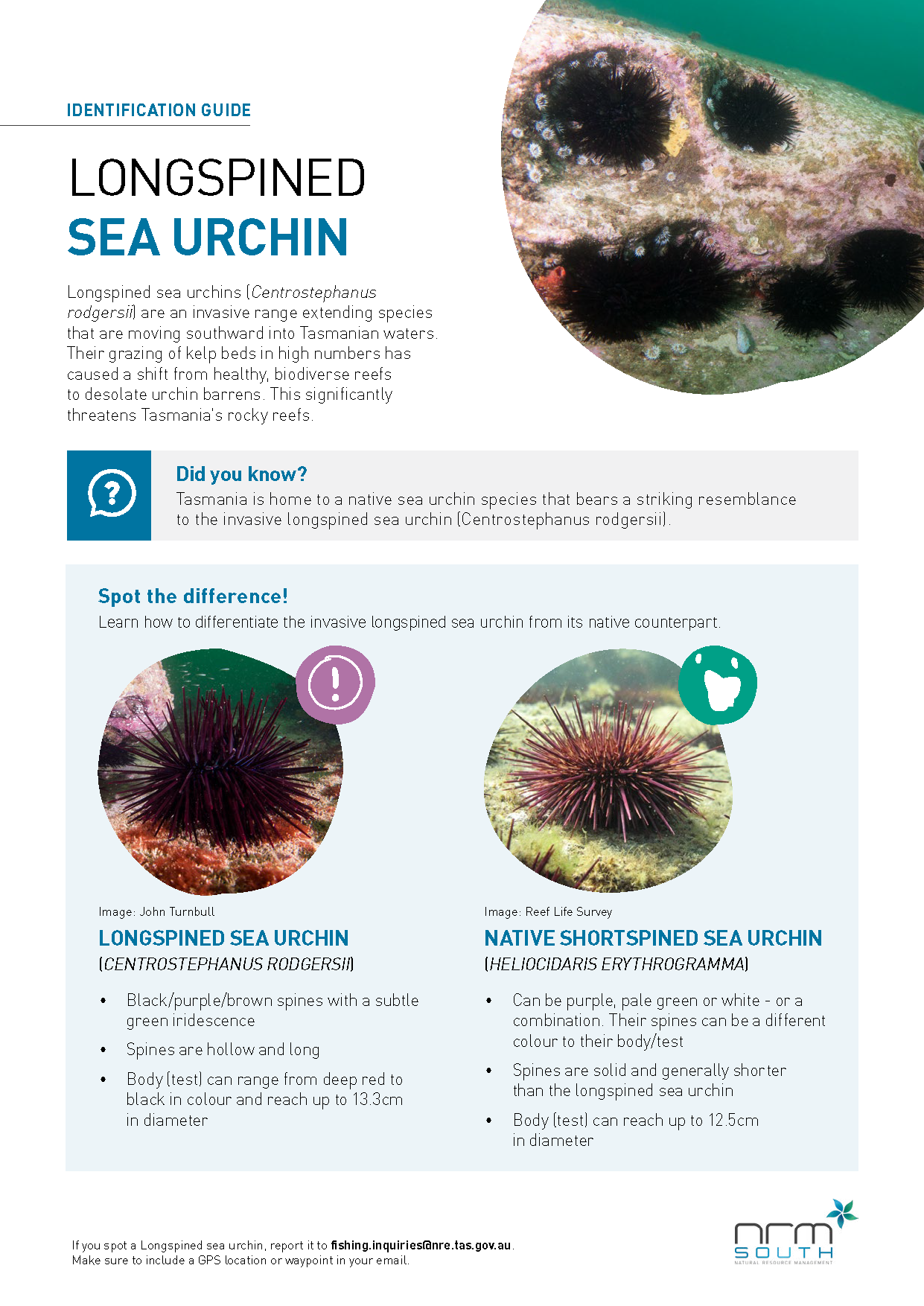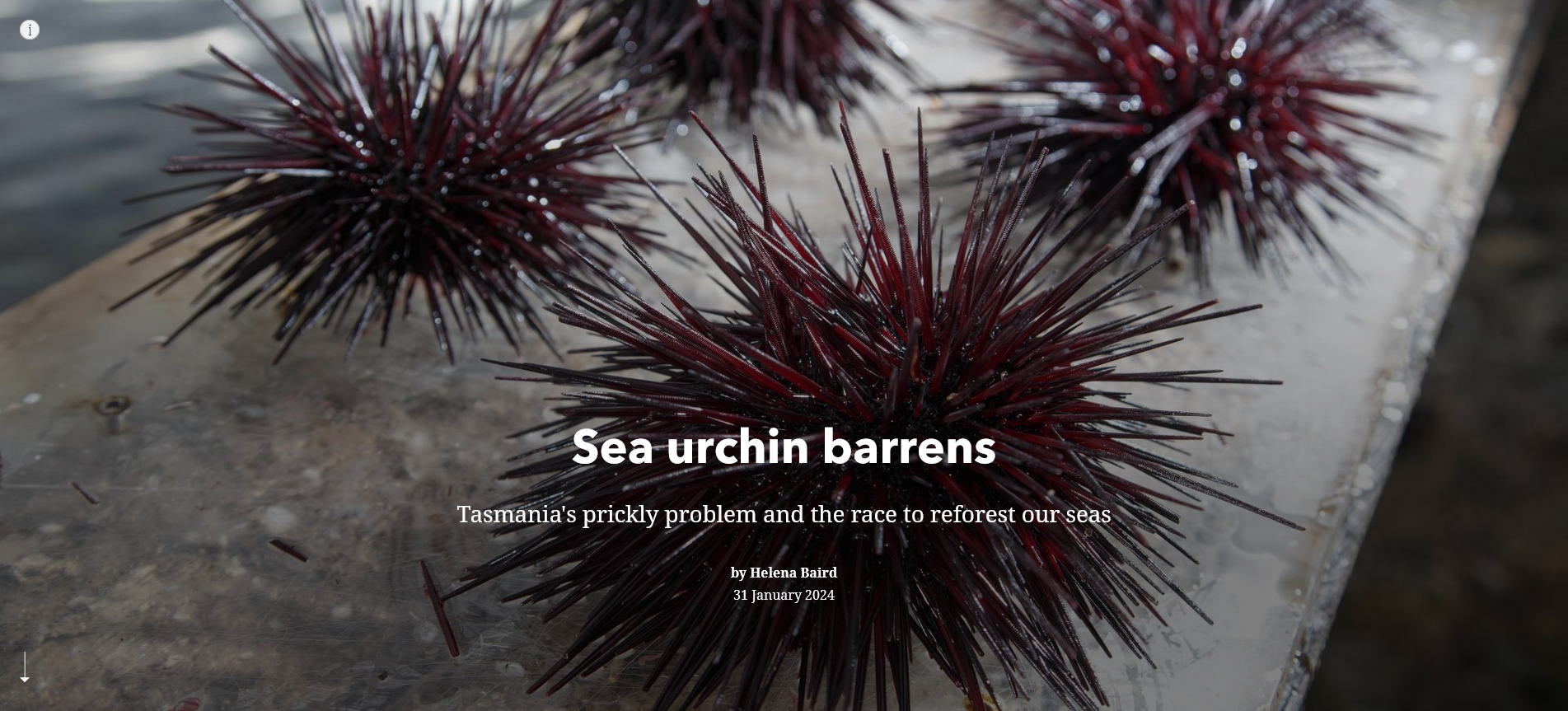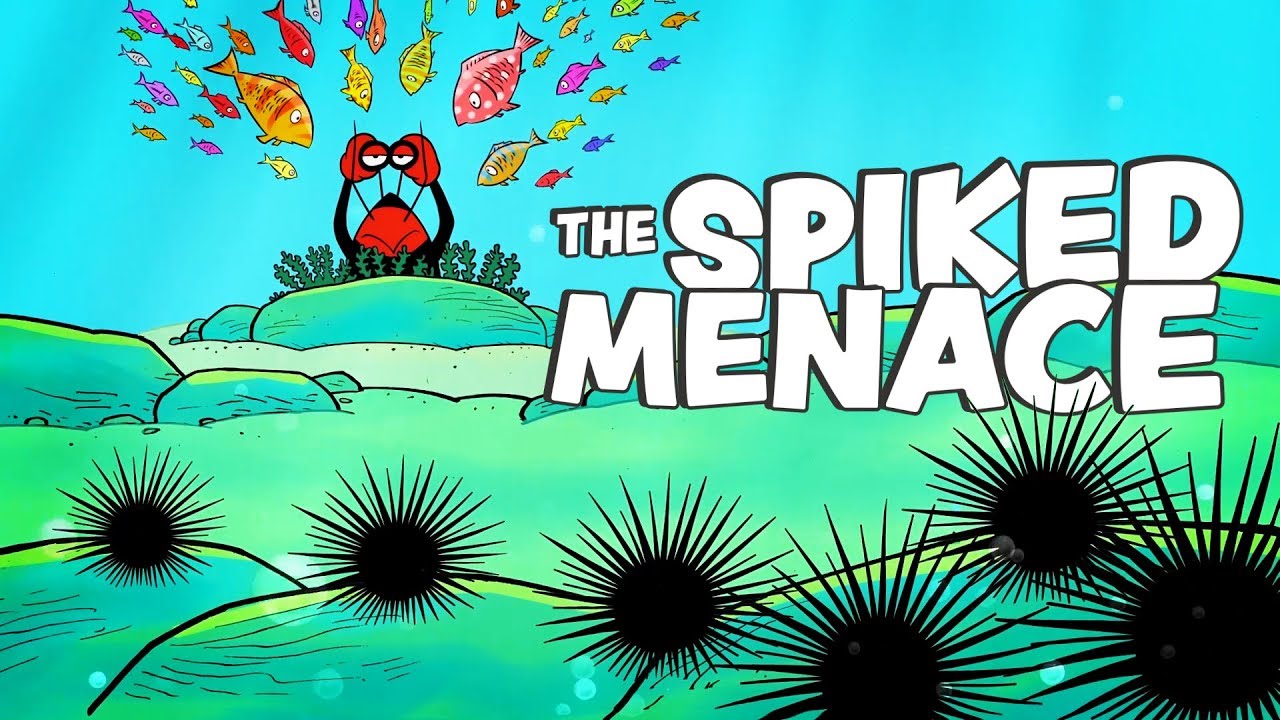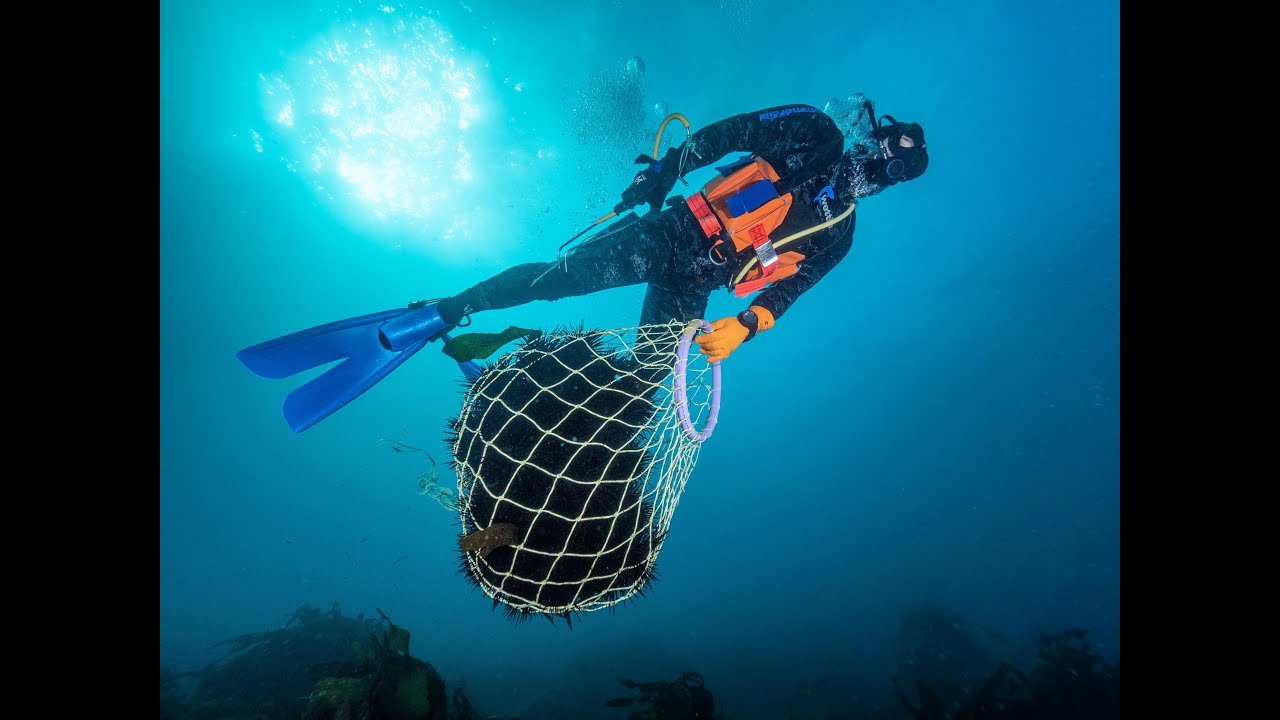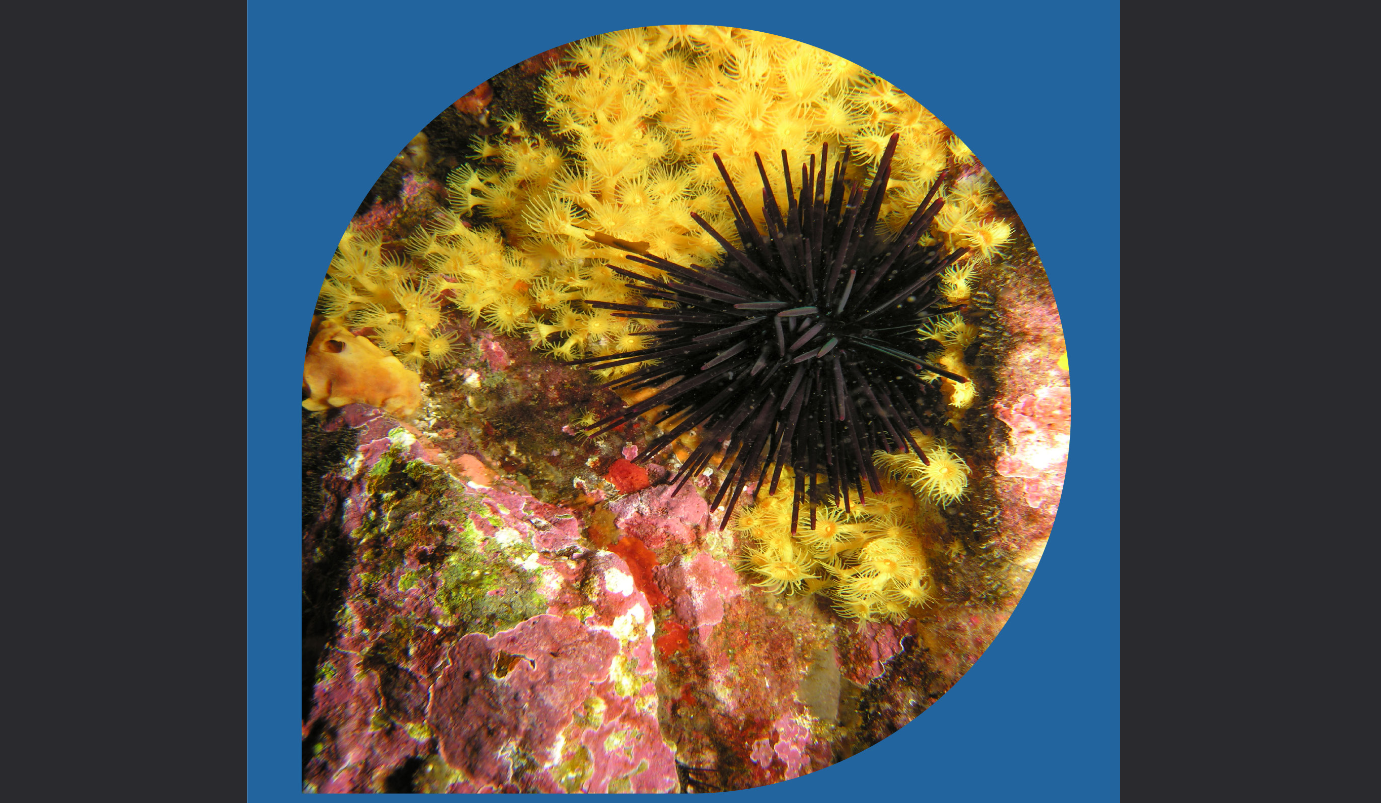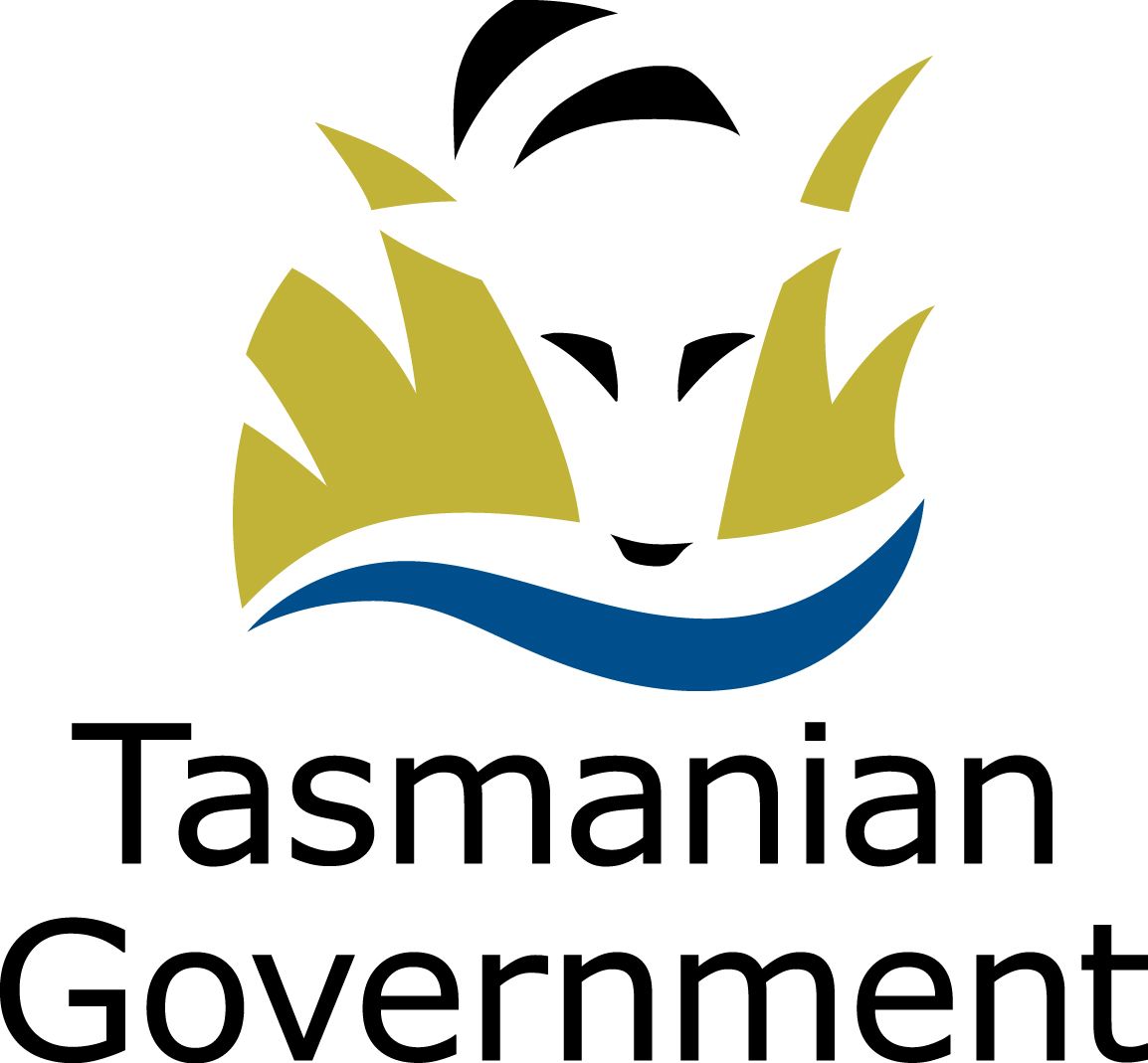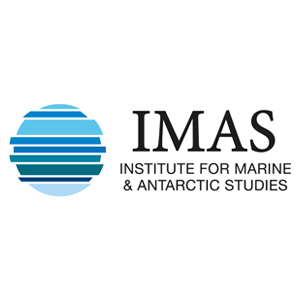Tackling Longspined Sea Urchins on Tasmania’s east coast
THE PROBLEM
The Longspined Sea Urchin (Centrostephanus rodgersii) has been steadily encroaching into Tasmanian waters since at least the late 1970s. This species moves on warming currents, and the increasing temperature of our oceans has allowed this urchin to establish in ever-increasing numbers. This ‘range-shifting’ behaviour is putting our rocky reef habitats at risk, as the urchins graze their way across the ocean floor, creating expansive barrens and destroying important habitat. This negatively impacts kelp beds and reef-dependent species such as abalone, rock lobster and fish, which have important commercial, recreational, and cultural value.
Across Australia’s temperate reefs, no other benthic herbivore has as large an effect on shallow reef communities as the Longspined Sea Urchin. They represent the single largest immediate environmental threat to rocky reef communities in eastern Tasmania.
NRM South is working to build community understanding and support for the commercial harvest of Longspined Sea Urchins in Tasmania, helping to reduce grazing pressure on our rocky reef habitats while opening opportunities in an emerging commercial market.
Video credit: Joshua Lamont
YOU CAN HELP
Although their numbers are on the rise, a commercial market has been established for the Longspined Sea Urchin, with commercial divers harvesting and profiting from the resource.
While it is impossible to eradicate this species, there are actions you can take to help manage this spiky issue:
- Eat the problem. Longspined sea urchin is considered a delicacy, and seafood lovers may want to try their hand with new urchin recipes
- Fish for it. Visit Fishing Tasmania for more information and keep an eye out for community organised events.
- Report it. Report any sightings of the longspined sea urchin to [email protected]. Make sure to include a GPS location or waypoint in your email.
- Talk about it. The more people that know about the species and its impacts, the better.
PROJECT PILLARS
Background
The Great Southern Reef spans 71,000km2, extending from the east to the west coast of Australia. Home to a diverse marine community, from Giant Kelp forests to diverse fish and shellfish species, the reef contributes over $10 billion p.a. to Australia’s economy (Bennett et al. 2015). The health of this ecosystem is under threat from a range of factors – particularly climate change, which is causing ocean temperatures off southeast Tasmania to warm by over two degrees in the past century (Ridgeway 2007). This warming trend has resulted in a phenomenon called range-extending, where changing conditions allow for the natural movement of species into new ecosystems. Native to NSW, this warming trend has seen Longspined Sea Urchins extending their range further south. First spotted in Tasmania in 1978, there are now over 20 million Longspined Sea Urchins in Tasmanian waters reaching as far down as Port Davey.
This expansion has devastating implications for Tasmanian reefs. The high numbers of urchins grazing on kelps beds has seen a functional shift in reef structure from healthy diverse reefs to desolate urchin barrens. Over 15% of Tasmania’s east coast now consists of unproductive urchin barrens. This has caused a significant loss in local biodiversity, with an observed population decrease in over 150 species reliant on Tasmania’s kelp beds (Ling 2008, Ling and Keane 2024). This in turn threatens commercial wild catch fisheries (e.g. abalone and rock lobster), cultural practices and other ecosystem services (e.g. recreational diving).
The Longspined Sea Urchin population is expected to continue to grow over the next century. It is estimated that over half of east Tasmania’s reefs could be subject to urchin barrens by the mid-2030s if no management strategies are implemented.
Management Strategies
There are various control measures in place to help manage the Longspined Sea Urchin population. As we are unable to completely eradicate the species in Tasmanian waters, commercial fishing in an important tool in ensuring numbers are reduced to better support the recovery of Tasmania’s reefs. Take-all harvests are also being explored, to ensure that all size classes are removed from an area.
Although lobsters are natural predators of the Longspined Sea Urchin, their impact on controlling the population is widely misunderstood. Research published in 2022, highlighted that Tasmanian native Southern Rock Lobsters (Jasus edwardsii) have a strong preference for native urchins, abalone and snails, compared to Longspined Sea Urchins. This indicates that their effectiveness in reducing grazing pressure and preventing the formation of barrens may be less than previously thought (Smith et al. 2022).
Fishing events can also be effective management strategies. Check in with your local dive club for community organised events. Before getting out in the water, it is important to ensure you are confidently able to identify the differences between the Tasmanian native Shortspined Sea Urchin (Heliocidaris erythrogramma) and the range extending, Longspined Sea Urchin.
Previous Work
This project further supports previous work that NRM South has conducted through out Tasmanian Smart Seafood Partnership. The Tasmanian Smart Seafood Partnership (TSSP) project was established in 2018 and delivered in collaboration with the Tasmanian Seafood Industry Council. The Partnership supports the adoption of processes and practices within the seafood industry which have positive outcomes for marine biodiversity.
In 2022 NRM South was invited by the NRE Tasmania and AIRF to determine the feasibility of a volunteer management program for Longspined Sea Urchin in Tasmania waters. This highlighted potential solutions for volunteers to work alongside industry to better manage the urchin population. This could potentially be a valuable tool, building social participating to address changes in the marine environment with outcomes for biodiversity in high value recreational areas.
Thanks to our key partner
This project is funded by the Abalone Industry Reinvestment Fund (AIRF), with the overarching objective to reduce the Longspined Sea Urchin on the East coast of Tasmania, supporting the health of Tasmania’s reefs.
This is a one-year project that commenced in July 2023 and ran until June 2024. NRM South is working closely with the Department of Natural Resources and Environment (NRE) Tasmania and the Institute for Marine and Antarctic Studies (IMAS) to develop key communication and engagement deliverables for the wider community.
